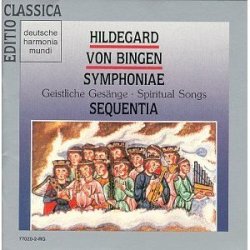Hildegard von Bingen – Symphoniae (1993)
Hildegard von Bingen – Symphoniae (1993)

1. O quam mirabilis est 2. O pulchrae facies 3. O virga ac diadema purpurae regis 4. Instrumentalstück 5. O clarissima Mater 6. Instrumentalstück 7. Spiritui Sancto honor sit 8. O virtus sapientiae play 9. O lucidissima Apostolorum turba 10. Instrumentalstück 11. O successores fortissimi leonis play 12. O vos, felices radices 13. Instrumentalstück 14. Vos flores rosarum Performer: Barbara Thornton (vocals), Margriet Tindemans (viola da gamba) & Sequentia: Benjamin Bagby – vocals, harp Agnethe Christensen – vocals, harp, fiddle Elizabeth Gaver – vocals, medieval fiddle Katarina Livljanić – vocals Lena Susanne Norin – vocals.
Sequentia’s Hildegard von Bingen Project: Initially in collaboration with the West German Radio Cologne (WDR Köln) Sequentia made a series of recordings of the complete works of Germany’s most important medieval composer, the abbess and visionary Hildegard von Bingen (1098-1179).
After recording the music drama, Ordo Virtutum, Sequentia went on to make a first recording of the abbess’s symphoniae, spiritual songs which were probably sung in the liturgy of her convent on the Rupertsberg in the late 12th century. A group of nine female vocalists under Barbara Thornton’s direction is complemented by five instrumentalists in this recording made over a period of a year, in two different medieval German churches. --- sequentia.org
Sequentia is one of the world’s most respected and innovative ensembles for medieval music. It is an international group of singers and instrumentalists – united in Paris under the direction of the legendary performer and teacher Benjamin Bagby – for performances and recordings of Western European music from the period before 1300. The size and disposition of the ensemble is determined by the repertoire being performed, and ranges between an instrumental/vocal duo to a large vocal ensemble. Based on meticulous research, intensive rehearsal and long gestation, Sequentia’s virtuosic performances are compelling, surprising in their immediacy, and strike the listener with a timeless emotional connection to our own past musical cultures. --- sequentia.org
Symphoniae is a reissue of the 1985 Sequentia LP Symphoniae: Spiritual Songs, an epochal recording that did much to set off the whole Hildegard boom -- if one can use that word to describe the audiences for music by a medieval German abbess. It is largely the work of Sequentia co-director Barbara Thornton, who died in 1998; her creative partner Benjamin Bagby is heard on harps and on other instruments. She sings solo and leads small groups of other female singers. "Symphoniae" was a word Hildegard herself applied to a collection of her own music.
For those who have gone on to investigate other treatments of Hildegard's music, ranging from hyper-authentic to new age inspirational, it will be good to check in with the musicians who were really the first to spot the tremendous relevance of this woman-centered chant. And for those who are looking for a good place to start with Hildegard of Bingen, this disc is still easy to recommend. In both music and liner notes it gives a feel for the key traits of Hildegard's music: its wide, sudden melodic swings, its rhapsodic quality, the unusual locutions and involved, imaginative metaphors in her poetry, and some great imagery that could almost have come out of 1970s feminist literature. In the words of one commentator, Hildegard "used extremes of register as if to bring heaven and earth together," and Sequentia's singers pick up this momentum effectively. A responsory in praise of St. Ursula and her 11,000 martyred Virgins (actually, there may have been only 11) has become especially well known in the years since this album was released. Many of the pieces praise saints and other figures from Christian history and liturgy (often women), and some become mystical in their intensity.
Musically the album takes liberties with what is known of medieval performance practice, but not to an objectionable degree. Some of the chants are sung solo, other responsorially between soloist and choir in the usual manner. On some pieces the performers add vocal harmonies according to the principles of medieval organum singing, something not notated by Hildegard but certainly in the air in her time and place. There are also several pieces done instrumentally, and some of the chants are accompanied by a small instrumental ensemble. The reason often given (and alluded to here) is that Hildegard's writings mention musical instruments as a link to the divine. It's a stretch from that idea to the instrumental accompaniment of music that is usually heard for voices alone, but the results here are lovely. For everyone from medievalists to ordinary mystics, Symphoniae offers worthwhile listening. --- James Manheim, allmusic.com
download: uploaded solidfiles anonfiles yandex 4shared mediafire mega filecloudio nornar
Zmieniony (Wtorek, 07 Styczeń 2014 23:29)








